Analysis of the Productive, Structural, and Dynamic Development of Augmented Reality in Higher Education Research on the Web of Science
Abstract
1. Introduction
- Evaluating the performance of and scientific productions on ARHE.
- Establishing the scientific evolution of ARHE in the specialized literature.
- Discovering the most important topics in the scientific literature on ARHE.
- Identifying the most relevant authors who study ARHE.
2. Materials and Methods
2.1. Research Design
2.2. Procedure, Debugging, and Data Analysis
- Upper left: entrenched but isolated issues;
- Upper right: motor and essential issues;
- Bottom left: issues that are a priori booming or, on the contrary, are disappearing;
- Bottom right: poorly developed and transversal issues.
3. Results
3.1. Performance and Scientific Production
3.2. Structural and Thematic Development
3.3. Thematic Evolution of the Terms
3.4. Authors with a Higher Relevance Index
4. Discussion and Conclusions
Author Contributions
Funding
Acknowledgments
Conflicts of Interest
References
- Rodríguez, A.M.; Cáceres, M.P.; Alonso, S. La competencia digital del futuro docente: Análisis bibliométrico de la productividad científica indexada en Scopus. Int. J. Innov. Educ. Res. 2018, 10, 317–333. [Google Scholar]
- Viñals, A.; Cuenca, J. El rol del docente en la era digital. Rev. Interuniv. Form. del Profr. 2016, 30, 103–114. [Google Scholar]
- Fombona, J.; Pascual, M.Á. La producción científica sobre Realidad Aumentada, un análisis de la situación educativa desde la perspectiva SCOPUS. EDMETIC 2017, 6, 39–61. [Google Scholar] [CrossRef]
- Radu, I. Augmented reality in education: A meta-review and cross-media analysis. Pers. Ubiquitous Comput. 2014, 18, 1533–1543. [Google Scholar] [CrossRef]
- Villalustre, L.; del Moral, M.E. Juegos perceptivos con realidad aumentada para trabajar contenido científico. Educ. Form. Tecnol. 2017, 10, 36–46. [Google Scholar]
- Marín, V.; Muñoz, V.P. Trabajar el cuerpo humano con realidad aumentada en educación infantil. Rev. Tecnol. Cienc. y Educ. 2018, 9, 148–158. [Google Scholar]
- Area, M.; Hernández, V.; Sosa, J.J. Modelos de integración didáctica de las TIC en el aula. Comunicar 2016, 24, 79–87. [Google Scholar] [CrossRef]
- Castañeda, L.; Esteve, F.; Adell, J. ¿Por qué es necesario repensar la competencia docente para el mundo digital? RED 2018, 56, 1–20. [Google Scholar] [CrossRef]
- Fuentes, A.; López, J.; Pozo, S. Analysis of the Digital Teaching Competence: Key Factor in the Performance of Active Pedagogies with Augmented Reality. REICE 2019, 17, 27–42. [Google Scholar] [CrossRef]
- Castellanos, A.; Sánchez, C.; Calderero, J.F. Nuevos modelos tecnopedagógicos. Competencia digital de los alumnos universitarios. Rev. Electrn. Investig. Educ. 2017, 19, 1–9. [Google Scholar] [CrossRef]
- Prendes, M.P.; Gutiérrez, I.; Martínez, F. Competencia digital: Una necesidad del profesorado universitario en el siglo XXI. RED 2018, 56, 1–22. [Google Scholar] [CrossRef]
- Cabero, J.; Barroso, J. Los escenarios tecnológicos en Realidad Aumentada (RA): Posibilidades educativas en estudios universitarios. Aula Abierta 2018, 47, 327–336. [Google Scholar] [CrossRef]
- Cabero, J.; Roig, R. The motivation of technological scenarios in augmented reality (AR): Results of different experiments. Appl. Sci. 2019, 9, 2907. [Google Scholar] [CrossRef]
- Rodríguez, A.M.; Hinojo, F.J.; Ágreda, M. Diseño e implementación de una experiencia para trabajar la interculturalidad en Educación Infantil a través de realidad aumentada y códigos QR. Educar 2019, 55, 59–77. [Google Scholar] [CrossRef]
- Chen, P.; Liu, X.; Cheng, W.; Huang, R. A review of using Augmented Reality in Education from 2011 to 2016. In Innovations in Smart Learning; Popescu, E., Kinshuk, M.K., Huang, R., Jemni, M., Chen, N.S., Sampson, D.G., Eds.; Springer: Singapore, 2017; pp. 13–18. [Google Scholar] [CrossRef]
- Barroso, J.; Cabero, J.; García, F.; Calle, F.M.; Gallego, Ó.; Casado, I. Diseño, Producción, Evaluación y Utilización Educativa de la Realidad Aumentada, 1st ed.; Secretariado de Recursos Audiovisuales y NNTT de la Universidad de Sevilla: Sevilla, Spain, 2017; pp. 55–92. Available online: https://cutt.ly/5etacaZ (accessed on 2 December 2019).
- Gómez, M.; Trujillo, J.M.; Aznar, I.; Cáceres, M.P. Augment reality and virtual reality for the improvement of spatial competences in Physical Education. J. Hum. Sport Exerc. 2018, 13, 189–198. [Google Scholar] [CrossRef]
- López, J.; Pozo, S.; López, G. La eficacia de la realidad aumentada en las aulas de infantil: Un estudio del aprendizaje de SVB y RCP en discentes de 5 años. Pixel-Bit 2019, 55, 157–178. [Google Scholar] [CrossRef]
- Garay, U.; Tejada, E.; Castaño, C. Percepciones del alumnado hacia el aprendizaje mediante objetos educativos enriquecidos con realidad aumentada. EDMETIC 2017, 6, 145–164. [Google Scholar] [CrossRef]
- Cabero, J.; Llorente, M.C.; Marín, V. Comunidades virtuales de aprendizaje. El Caso del proyecto de realidad aumentada: RAFODIUM. Perspect. Educ. 2017, 56, 117–138. [Google Scholar] [CrossRef]
- Bacca, J.; Baldiris, S.; Fabregat, R.; Graf, S.; Kinshuk. Augmented reality trends in education: A systematic review of research and applications. Educ. Technol. Soc. 2014, 17, 133–149. [Google Scholar]
- Marín, V.; Cabero, J.; Gallego, O.M. Motivación y realidad aumentada: Alumnos como consumidores y productores de objetos de aprendizaje. Aula Abierta 2018, 47, 337–346. [Google Scholar] [CrossRef]
- Cheng, K.H. Reading an augmented reality book: An exploration of learners’cognitive load, motivation, and attitudes. Australas. J. Educ. Technol. 2017, 33, 53–69. [Google Scholar] [CrossRef]
- Fombona, J.; Vázquez, E. Posibilidades de utilización de la Geolocalización y Realidad Aumentada en el ámbito educativo. Educ. XX1 2017, 20, 319–342. [Google Scholar] [CrossRef]
- Toledo, P.; Sánchez, J.M. Realidad Aumentada en Educación Primaria: Efectos sobre el aprendizaje. RELATEC 2017, 16, 79–92. [Google Scholar] [CrossRef]
- Cabero, J.; Llorente, C.; Gutiérrez, J.J. Evaluación por y desde los usuarios: Objetos de aprendizaje con Realidad aumentada. RED 2017, 53, 1–17. [Google Scholar] [CrossRef]
- Kamphuis, C.; Barsom, E.; Schijven, M.; Christoph, N. Augmented reality in medical education? Perspect. Med. Educ. 2014, 3, 300–311. [Google Scholar] [CrossRef]
- Yuen, S.C.; Yaoyuneyong, G.; Johnson, E. Augmented Reality and Education: Applications and Potentials, 1st ed.; Springer: Berlin/Heidelberg, Germany, 2013; pp. 77–92. [Google Scholar] [CrossRef]
- Prendes, C. Realidad aumentada y educación: Análisis de experiencias prácticas. Pixel-Bit. Rev. Medios Educ. 2015, 46, 187–203. [Google Scholar] [CrossRef]
- Suh, A.; Prophet, J. The state of immersive technology research: A literature analysis. Comput. Hum. Behave. 2018, 86, 77–90. [Google Scholar] [CrossRef]
- Muhamedyev, R.I.; Aliguliyev, R.M.; Shokishalov, Z.M.; Mustakayev, R.R. New Bibliometric Indicators for Prospectivity Estimation of Research Fields. Ann. Libr. Inf. Stud. 2018, 65, 1–8. [Google Scholar]
- Fombona, J.; Pascual, M.Á.; González, M.C. M-learning y realidad aumentada: Revisión de literatura científica en el repositorio WoS. Comunicar 2017, 25, 63–72. [Google Scholar] [CrossRef]
- Lorenzo, G.; Scagliarini, C. Bibliometric review of augmented reality in education. Rev. Gen. Inf. Doc. 2018, 28, 45–60. [Google Scholar] [CrossRef]
- Heradio, R.; de la Torre, L.; Galán, D.; Cabrerizo, F.J.; Herrera, E.; Dormido, S. Virtual and remote labs in education: A bibliometric analysis. Comput. Educ. 2016, 98, 14–38. [Google Scholar] [CrossRef]
- Álvarez, A.; Castillo, M.; Geldes, C. Análisis Bibliométrico de la Realidad Aumentada y su Relación con la Administración de Negocios. Inf. Tecnol. 2017, 28, 57–66. [Google Scholar] [CrossRef][Green Version]
- Jaramillo, A.M.; Silva, G.J.; Adarve, C.A.; Velásquez, S.M.; Páramo, C.A.; Gómez, L.L. Aplicaciones de Realidad Aumentada en educación para mejorar los procesos de enseñanza-aprendizaje: Una revisión sistemática. Rev. Espac. 2018, 39, 1–15. [Google Scholar]
- Karakus, M.; Ersozlu, A.; Clark, A.C. Augmented Reality Research in Education: A Bibliometric Study. J. Math. Sci. Technol. Educ. 2019, 15, 1–12. [Google Scholar] [CrossRef]
- Arici, F.; Yildirim, P.; Caliklar, Ş.; Yilmaz, R.M. Research trends in the use of augmented reality in science education: Content and bibliometric mapping analysis. Comput. Educ. 2019, 142, 1–13. [Google Scholar] [CrossRef]
- Martínez, M.A.; Cobo, M.J.; Herrera, M.; Herrera, E. Analyzing the scientific evolution of social work using science mapping. Res. Soc. Work Pract. 2015, 25, 257–277. [Google Scholar] [CrossRef]
- Moreno, A.J. Estudio Bibliométrico de la Producción Científica sobre la Inspección Educativa. REICE. Rev. Iberoam. Sobre Calid. Efic. Cambio Educ. 2019, 17, 23–40. [Google Scholar] [CrossRef]
- López-Robles, J.R.; Otegi-Olaso, J.R.; Porto, I.; Cobo, M.J. 30 years of intelligence models in management and business: A bibliometric review. Int. J. Inf. Manag. 2019, 48, 22–38. [Google Scholar] [CrossRef]
- Rodríguez-García, A.M.; López, J.; Agreda, M.; Moreno-Guerrero, A.J. Productive, Structural and Dynamic Study of the Concept of Sustainability in the Educational Field. Sustainability 2019, 11, 5613. [Google Scholar] [CrossRef]
- Hirsch, J.E. An index to quantify an individual’s scientific research output. Proc. Natl. Acad. Sci. USA 2005, 102, 16569–16572. [Google Scholar] [CrossRef]
- Cobo, M.J.; López, A.G.; Herrera, E.; Herrera, F. Science mapping software tools: Review, analysis, and cooperative study among tools. J. Am. Soc. Inf. Sci. Technol. 2011, 62, 1382–1402. [Google Scholar] [CrossRef]
- Kaufmann, H.; Schmalstieg, D. Mathematics and geometry education with collaborative augmented reality. Comput. Graphics 2002, 23, 339–345. [Google Scholar] [CrossRef]
- Martín-Gutiérrez, J.; Saorín, J.L.; Contero, M.; Alcaniz, M.; Pérez-López, D.C.; Ortega, M. Design and validation of an augmented book for spatial abilities development in engineering students. Comput. Graphics 2010, 34, 77–91. [Google Scholar] [CrossRef]
- Akcayir, M.; Akcayir, G. Advantages and challenges associated with augmented reality crossMark for education: A systematic review of the literature. Educ. Res. Rev. 2017, 20, 1–11. [Google Scholar] [CrossRef]
- Potkinjak, V.; Gardner, M.; Callaghan, V.; Mattila, P.; Guetl, C.; Petrovic, V.M.; Jovanovic, K. Virtual laboratories for education in science, technology, and engineering: A review. Comput. Educ. 2016, 95, 309–327. [Google Scholar] [CrossRef]
- Andujar, J.M.; Mejías, A.; Márquez, M.A. Augmented Reality for the Improvement of Remote Laboratories: An Augmented Remote Laboratory. IEEE Trans. Educ. 2011, 53, 492–500. [Google Scholar] [CrossRef]
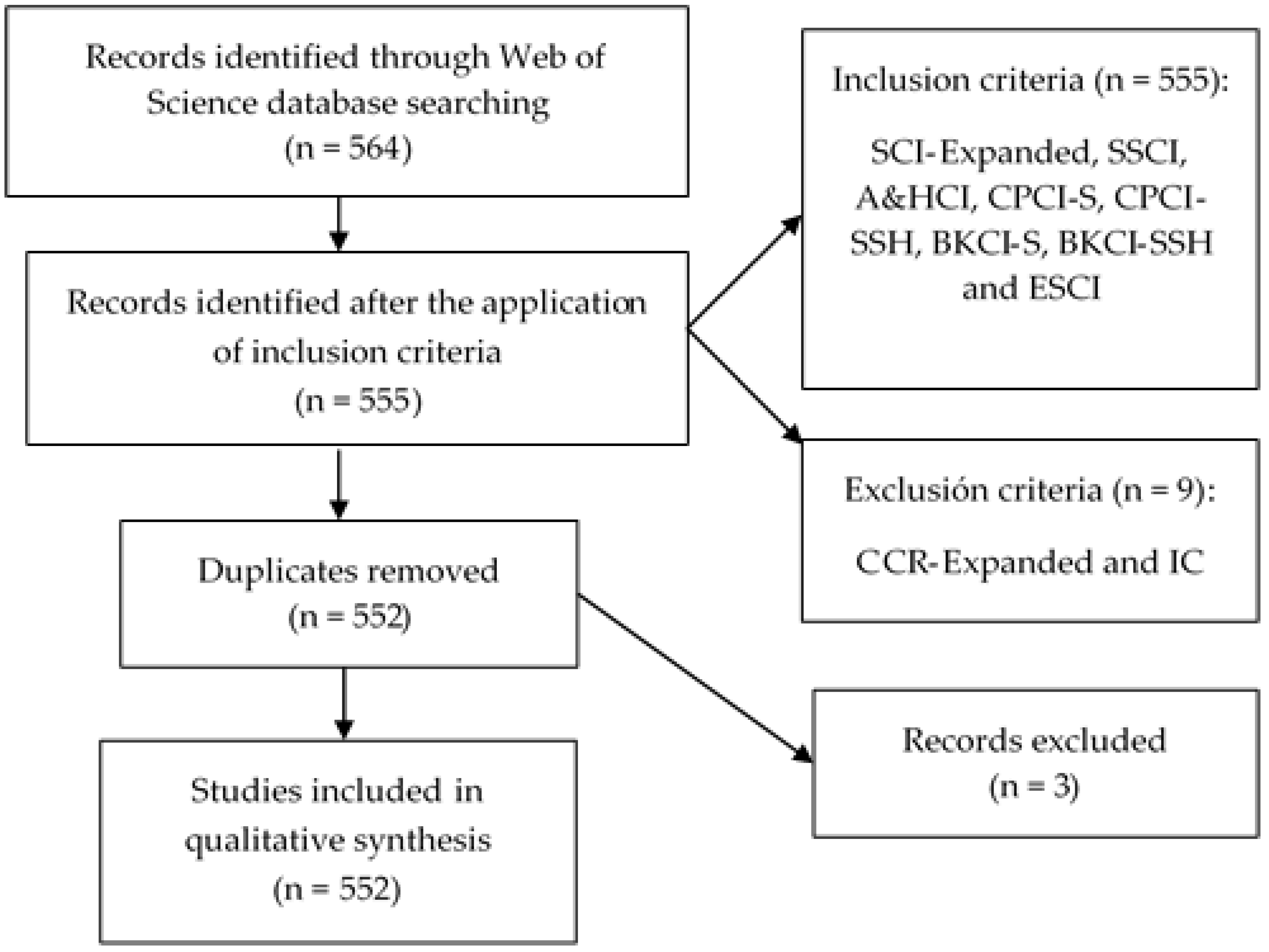
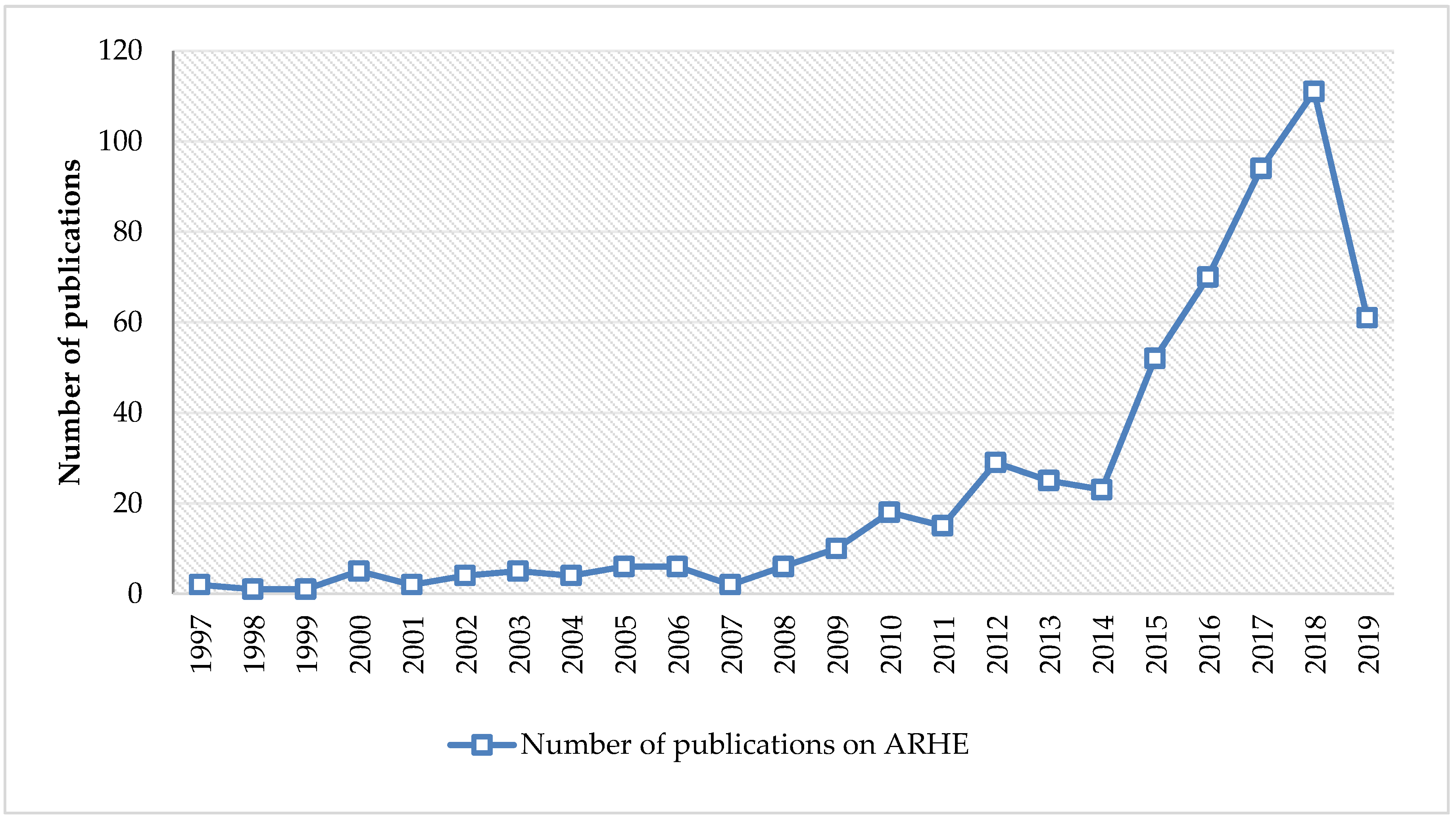
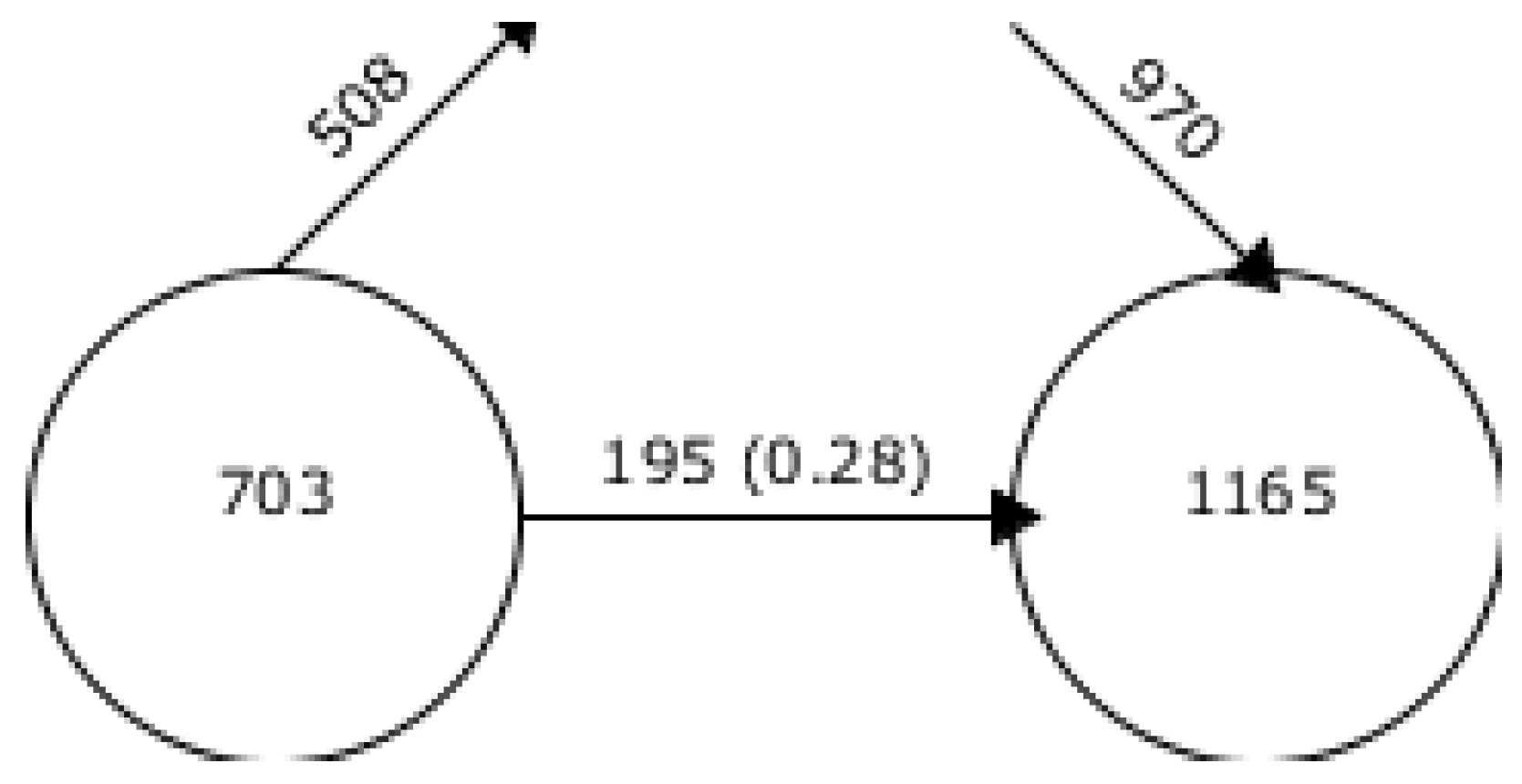
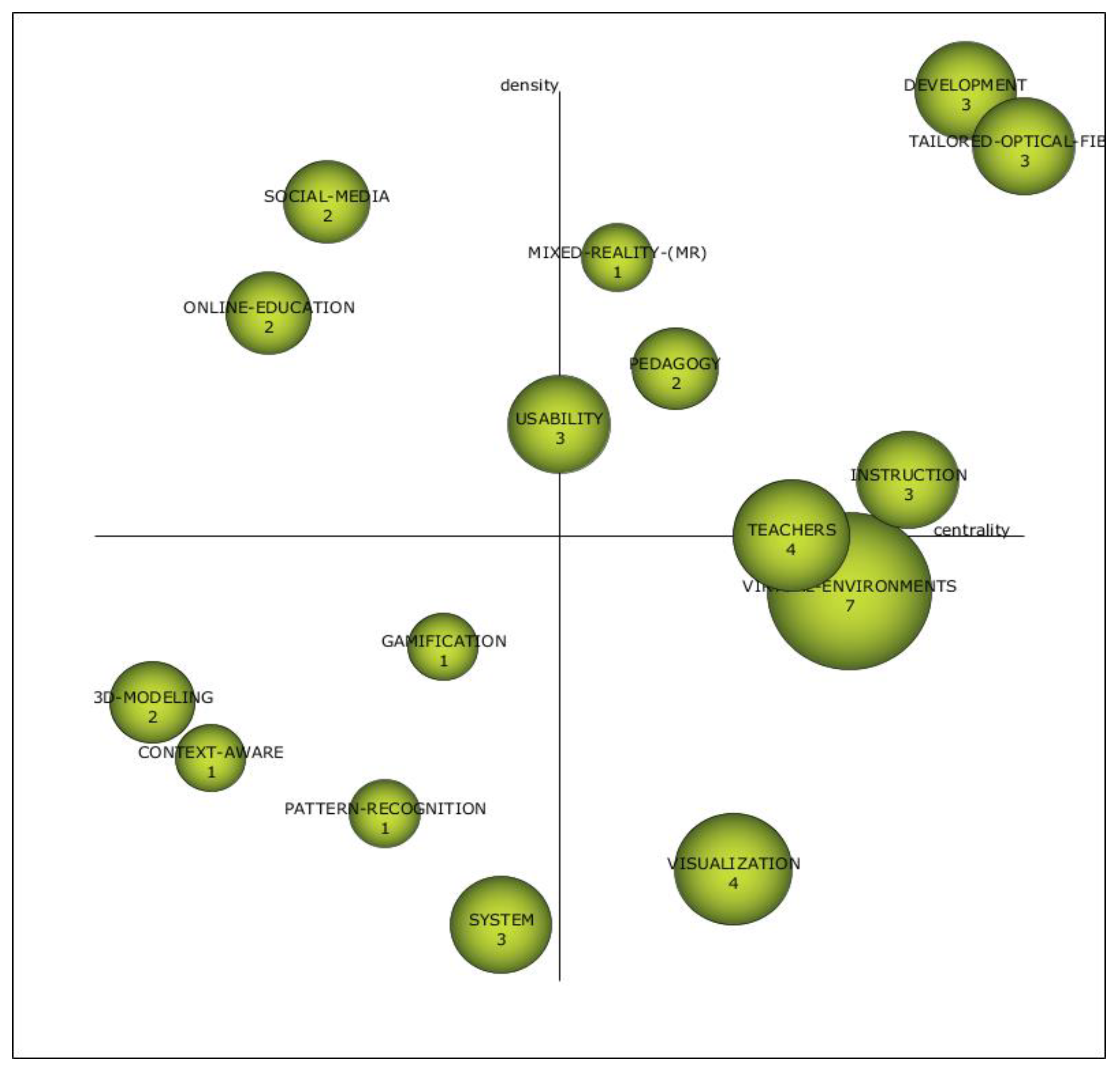
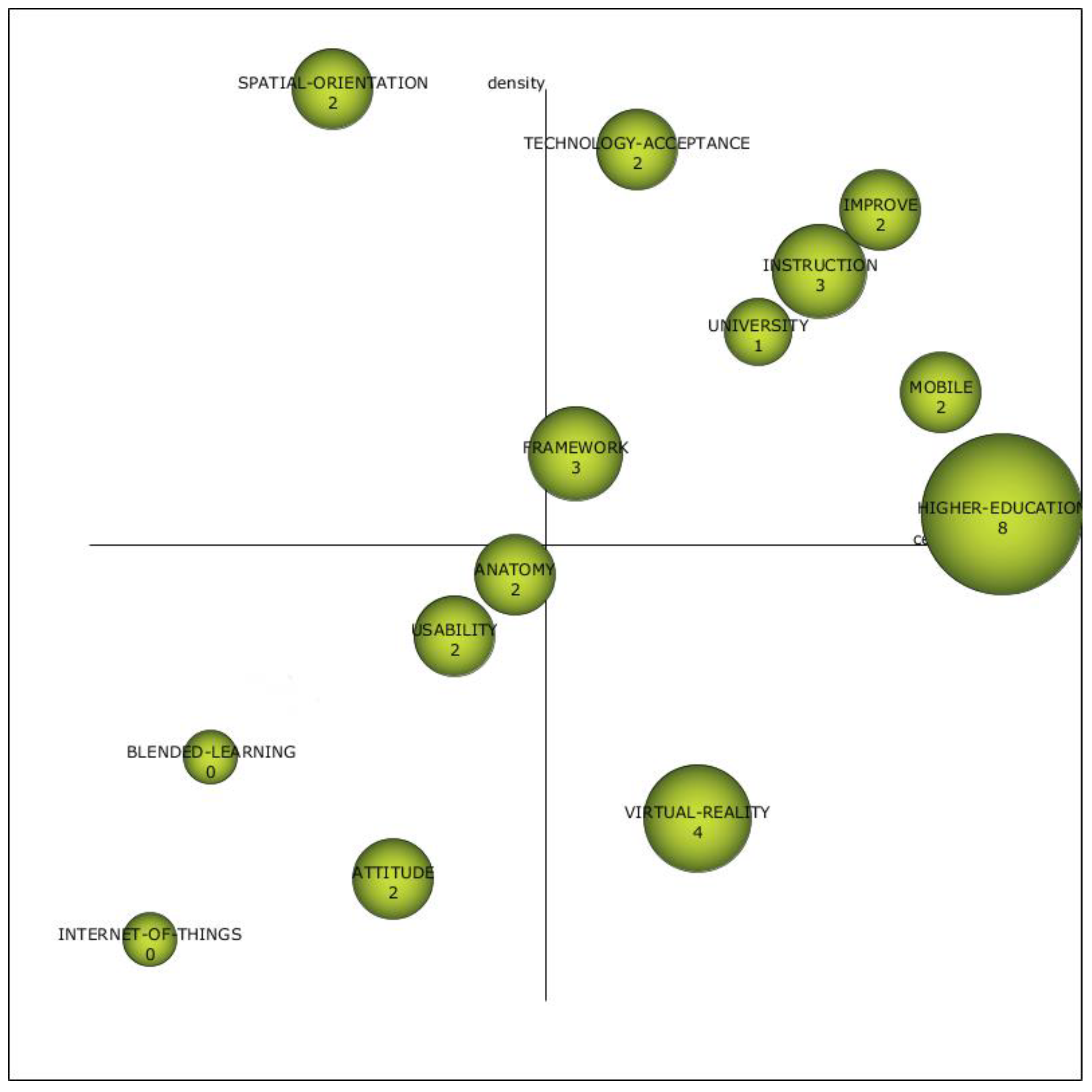
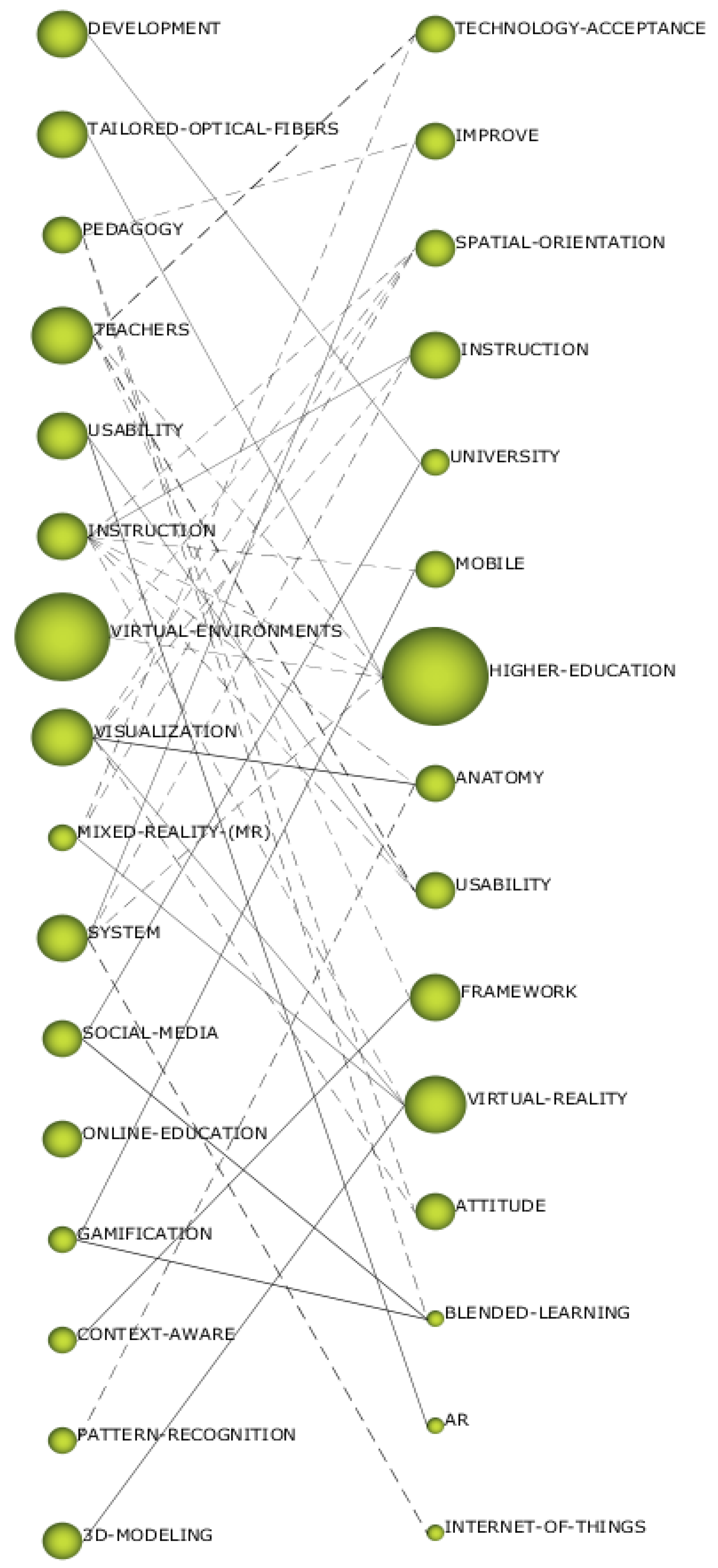
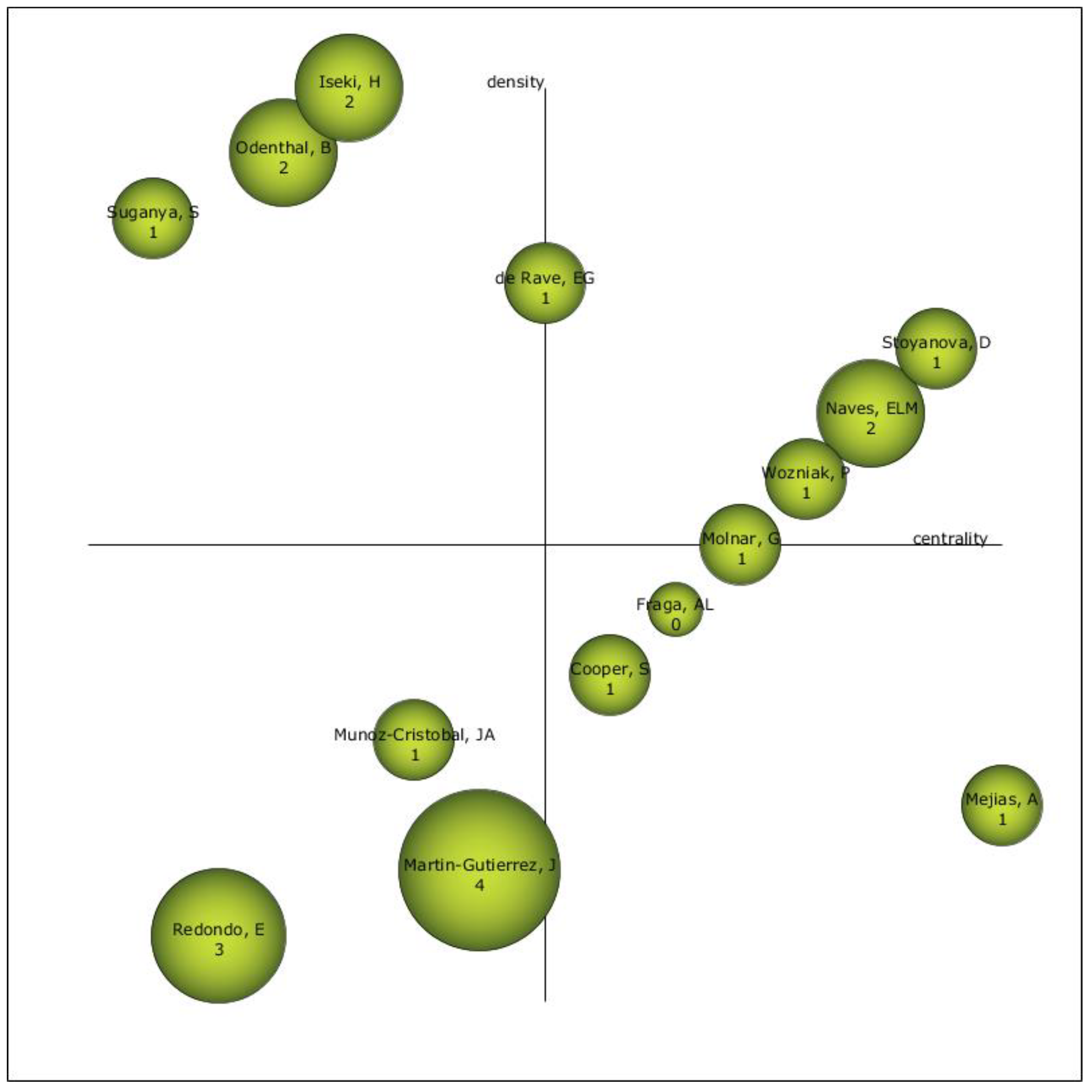
| Indicators | Criteria |
|---|---|
| Year of publication | All documents are contemplated |
| Language | All languages are contemplated |
| Publication Area | x ≥ 15 |
| Type of documents | All documents are contemplated |
| Organizations | x ≥ 5 |
| Authors | x ≥ 4 |
| Sources of Origin | x ≥ 6 |
| Countries | x ≥ 15 |
| Citation | The five most cited documents |
| Configuration | Values |
|---|---|
| Analysis unit | Keywords authors, keywords WoS |
| Frequency threshold | Keywords: P1 = (2), P2 = (3) |
| Authors: PX = (2) | |
| Network type | Co-occurrence |
| Co-occurrence union value threshold | Keywords: P1 = (1), P2 = (1) |
| Authors: PX = (2) | |
| Normalization measure | Equivalence index |
| Clustering algorithm | Maximum size: 9; Minimum size: 3 |
| Evolutionary measure | Jaccard index |
| Overlapping measure | Inclusion Rate |
| Institution | n |
|---|---|
| Universidad de La Laguna | 17 |
| Universidad de Sevilla | 15 |
| Universidad de Córdoba | 8 |
| Universitat Ramon Llull | 8 |
| Polytechnic University of Catalonia | 7 |
| Universitat Politécnica de Valencia | 7 |
| Universidad de Huelva | 6 |
| National Chiao Tung University | 5 |
| National Taiwan University of Science Technology | 5 |
| RWTH Aachen University | 5 |
| State University System of Florida | 5 |
| Universitat D’Alacant | 5 |
| University of Cambridge | 5 |
| Source | n |
|---|---|
| INTED Proceedings | 20 |
| EDULEARN Proceedings | 13 |
| Lecture Notes in Computer Science | 12 |
| Proceedings of SPIE | 12 |
| Procedia Computer Science | 10 |
| Procedia Social and Behavioral Sciences | 8 |
| Advances in Intelligent Systems and Computing | 6 |
| Business Horizons | 6 |
| Edmetic | 6 |
| Iceri Proceedings | 6 |
| INTED 2016 10th International Technology Education and Development Conference | 6 |
| Reference | Citations |
|---|---|
| Kaufmann, H.; Schmalstieg, D. [45] | 194 |
| Martín-Gutiérrez, J.; Saorín, J.L.; Contero, M.; Alcaniz, M.; Pérez-López, D.C.; Ortega, M. [46] | 114 |
| Akcayir, M.; Akcayir, G. [47] | 89 |
| Potkinjak, V.; Gardner, M.; Callaghan, V.; Mattila, P.; Guetl, C.; Petrovic, V.M.; Jovanovic, K. [48] | 83 |
| Andujar, J.M.; Mejías, A.; Márquez, M.A. [49] | 73 |
| Period 1997–2015 | ||||||
|---|---|---|---|---|---|---|
| Denomination | Works | h-Index | g-Index | hg-Index | q2-Index | Citations |
| Development | 3 | 3 | 3 | 3 | 7.75 | 56 |
| Tailored optical fibers | 3 | 3 | 3 | 3 | 7.75 | 56 |
| Pedagogy | 5 | 2 | 3 | 2.45 | 4.9 | 24 |
| Teachers | 4 | 4 | 4 | 4 | 9.8 | 92 |
| Usability | 5 | 3 | 3 | 3 | 7.55 | 51 |
| Instruction | 5 | 3 | 3 | 3 | 7.35 | 54 |
| Virtual environments | 12 | 7 | 9 | 7.94 | 18.52 | 492 |
| Visualization | 9 | 4 | 7 | 5.29 | 7.75 | 57 |
| Mixed reality | 4 | 1 | 2 | 1.41 | 4.69 | 23 |
| System | 5 | 3 | 4 | 3.46 | 9.17 | 102 |
| Social media | 3 | 2 | 2 | 2 | 2.45 | 8 |
| Online education | 2 | 2 | 2 | 2 | 6.48 | 30 |
| Gamification | 3 | 1 | 2 | 1.41 | 3.46 | 13 |
| Context Aware | 2 | 1 | 1 | 1 | 2.24 | 5 |
| Pattern recognition | 2 | 1 | 1 | 1 | 1 | 1 |
| 3D modeling | 3 | 2 | 3 | 2.45 | 8.12 | 42 |
| Period 2016–2019 | ||||||
| Technology acceptance | 6 | 2 | 3 | 2.45 | 3.46 | 12 |
| Improvement | 6 | 2 | 2 | 2 | 2.45 | 7 |
| Spatial orientation | 4 | 2 | 3 | 2.45 | 5.48 | 32 |
| Instruction | 5 | 3 | 3 | 3 | 13.64 | 173 |
| University | 6 | 1 | 1 | 1 | 1 | 2 |
| Mobile | 12 | 2 | 3 | 2.45 | 3.74 | 15 |
| Higher education | 68 | 8 | 16 | 11.31 | 11.31 | 294 |
| Anatomy | 5 | 2 | 2 | 2 | 6.48 | 23 |
| Usability | 5 | 2 | 2 | 2 | 3.46 | 8 |
| Framework | 6 | 3 | 6 | 4.24 | 4.58 | 82 |
| Virtual reality | 21 | 4 | 5 | 4.47 | 8 | 51 |
| Attitude | 4 | 2 | 3 | 2.45 | 2.83 | 10 |
| Blended learning | 4 | 0 | 0 | 0 | 0 | 0 |
| Internet of things | 2 | 0 | 0 | 0 | 0 | 0 |
© 2019 by the authors. Licensee MDPI, Basel, Switzerland. This article is an open access article distributed under the terms and conditions of the Creative Commons Attribution (CC BY) license (http://creativecommons.org/licenses/by/4.0/).
Share and Cite
López Belmonte, J.; Moreno-Guerrero, A.-J.; López Núñez, J.A.; Pozo Sánchez, S. Analysis of the Productive, Structural, and Dynamic Development of Augmented Reality in Higher Education Research on the Web of Science. Appl. Sci. 2019, 9, 5306. https://doi.org/10.3390/app9245306
López Belmonte J, Moreno-Guerrero A-J, López Núñez JA, Pozo Sánchez S. Analysis of the Productive, Structural, and Dynamic Development of Augmented Reality in Higher Education Research on the Web of Science. Applied Sciences. 2019; 9(24):5306. https://doi.org/10.3390/app9245306
Chicago/Turabian StyleLópez Belmonte, Jesús, Antonio-José Moreno-Guerrero, Juan Antonio López Núñez, and Santiago Pozo Sánchez. 2019. "Analysis of the Productive, Structural, and Dynamic Development of Augmented Reality in Higher Education Research on the Web of Science" Applied Sciences 9, no. 24: 5306. https://doi.org/10.3390/app9245306
APA StyleLópez Belmonte, J., Moreno-Guerrero, A.-J., López Núñez, J. A., & Pozo Sánchez, S. (2019). Analysis of the Productive, Structural, and Dynamic Development of Augmented Reality in Higher Education Research on the Web of Science. Applied Sciences, 9(24), 5306. https://doi.org/10.3390/app9245306








